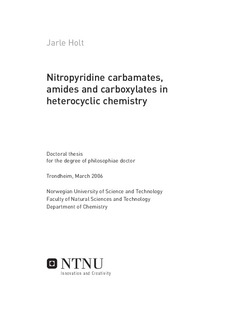| dc.contributor.author | Holt, Jarle | nb_NO |
| dc.date.accessioned | 2014-12-19T13:20:34Z | |
| dc.date.available | 2014-12-19T13:20:34Z | |
| dc.date.created | 2008-01-21 | nb_NO |
| dc.date.issued | 2006 | nb_NO |
| dc.identifier | 123319 | nb_NO |
| dc.identifier.isbn | 82-471-7833-8 | nb_NO |
| dc.identifier.uri | http://hdl.handle.net/11250/247441 | |
| dc.description.abstract | Based on new methodology for nitration of pyridine and pyridine derivatives developed at our department by Professor Jan Bakke and coworkers at NTNU, a whole range of substituted nitropyridines are now readily available. The method provides new possibilities in heterocyclic chemistry for the preparation of new materials. Due to the importance and useful properties of many pyridine-based compounds, the chemistry of nitropyridine derivatives is being investigated by our group at NTNU and results for nitropyridine carbamates, amides and carboxylates are presented in this thesis. These nitropyridine derivatives have been used as substrates for the formation of new bisheterocyclic compounds and pyridine derivatives. New synthetic routes to fused heterocycles have been developed.
Chapter 2 and Paper I presents the preparation, stability and reactivity of nitropyridine isocyanates (13, 23), a new class of compounds in organic chemistry. The introduction of an electronegative substituent represented by the nitro group was expected to reduce the basisity of the pyridine nitrogen, hence decrease the rate of dimerisation and increase the reactivity of the isocyanate carbon towards a nucleophile. The preparation of nitropyridine isocyanates (13, 23) are reported.
Isocyanates constitute an important class of compounds in organic chemistry and undergo a series of reactions to yield a variety of interesting products includingheterocyclic derivatives. Heterocyclic isocyanates, however, have not received the same attention as the respective aromatic compounds in synthesis and reactivity studies because of their instability and high reactivity. 2-Pyridine isocyanate dimerises while the 4-isomer trimerises to form the trimer.
Chapter 3 and Paper I presents the preparation, stability and reactivity of the isocyanate dimer and trimer. The isocyanate dimer (28) was formed in high yield from the reactive 5-nitro-2-pyridine isocyanate (23) by a [2+4]-cycloaddition reaction. Another byproduct in the preparation of the isocyanate using oxalyl chloride was the tetrone (26).
The isocyanate trimer was formed from the unstable 4-pyridine isocyanate for reference purposes. The trimer proved to be less stable than previously reported and afforded 4-aminopyridine and methyl 4-pyridine carbamate as decomposition products in the presence of moisture and alcohols, respectively. This demonstrates that the reactive trimer can be used as a protected version of the isocyanate for synthetic purposes.
Chapter 4 and Paper II presents studies of the nitropyridine isocyanates in cycloaddition reactions. The reactivity of the nitropyridine isocyanates in 1,3-dipolar cycloaddition reactions with trimethylsilylazide and 3,5-dimethylpyridine N-oxide to afford tetrazolinones (41, 43) and substituted amines (52, 55) was investigated. A [2+4]-cycloaddition reaction of nitropyridine isocyanate with diphenylketene was also studied. The cycloadduct (59) was formed. These results demonstrate the potential of the nitropyridine isocyanates to undergo cycloaddition reactions.
Application of nitropyridine carbamates, amides and carboxylates in the formation of new heterocyclic compounds have been investigated and discussed in Chapter 5-7.
Chapter 5 and Paper III presents the aromatic nucleophilic substitution reaction of the nitro group of methyl 3-nitro-4-pyridine carboxylate. The nitro group was successfully replaced by nitrogen, oxygen and sulfur nucleophiles to afford the substitution products (16a-d) in moderate yields.
Chapter 6 and Paper IV presents the cyclization reaction of nitropyridine carbamates for the formation of 1,3-dihydro-2H-imidazo[4,5-c]pyridin-2-one (79a-b), a biologically active compound. A facile acid-catalysed cyclization method for the preparation of the cyclic urea by traditional heating and the corresponding microwave-promoted reaction were developed. Both methods afforded the cyclic urea in high yield and represent a “green method” for the preparation of this compound.
Chapter 7 and Paper V presents the preparation of 1H-1,2,3-triazol [4,5-c]pyridine (86) and N-acyl and N-alkoxycarbonyl triazolo[4,5-c]pyridine derivatives (96a-e, 98a-e). The triazolopyridine derivatives were readily formed by diazotization and cyclization of the respective nitropyridine carbamates and amides in high yields. The application of triazolo[4,5-c]pyridine derivatives (98a-e) in the acylation of amines and amino acids was investigated. They proved to be more effective than the commercially available benzotriazole and afforded the protected amines in high yields under mild conditions. | nb_NO |
| dc.language | eng | nb_NO |
| dc.publisher | Fakultet for naturvitenskap og teknologi | nb_NO |
| dc.relation.ispartofseries | Doktoravhandlinger ved NTNU, 1503-8181; 2006:44 | nb_NO |
| dc.relation.haspart | Holt, Jarle; Andreassen, Trygve; Bakke, Jan M.; Fiksdahl, Anne. Nitropyridyl isocyanates. J. Heterocyclic Chem.. 42: 259-264, 2005. | nb_NO |
| dc.relation.haspart | Holt, Jarle; Fiksdahl, Anne. Nitropyridyl isocyanates in 1,3-dipolar cycloaddition reactions. J. Heterocyclic Chem.. 43, 2006. | nb_NO |
| dc.relation.haspart | Holt, Jarle; Tjosås, Freddy; Bakke, Jan M; Fiksdahl, Anne. Nucleophilic aromatic substitution of methyl 3-nitropyridine-4-carboxylate. J. Heterocyclic Chem. 41: 987-989, 2004. | nb_NO |
| dc.relation.haspart | Holt, Jarle; Bakke, Jan M.; Fiksdahl, Anne. 1,3-Dihydro-2H-imidazo[4,5-c]pyridin-2-one. J. Heterocyclic Chem.. 43, 2006. | nb_NO |
| dc.title | Nitropyridine carbamates, amides and carboxylates in heterocyclic chemistry | nb_NO |
| dc.type | Doctoral thesis | nb_NO |
| dc.contributor.department | Norges teknisk-naturvitenskapelige universitet, Fakultet for naturvitenskap og teknologi, Institutt for kjemi | nb_NO |
| dc.description.degree | PhD i kjemi | nb_NO |
| dc.description.degree | PhD in Chemistry | en_GB |
